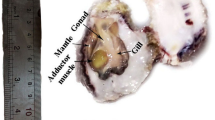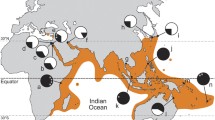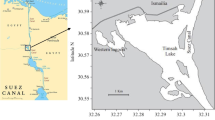Abstract
The gametogenic cycle of the pearl oyster, Pinctada radiata, from the Zarat region (Gulf of Gabès) in Tunisia was investigated monthly during a 1-year study of the reproductive cycle. Gametogenic activity was determined based on histological analysis of the gonads during the study period. P. radiata was found to have a clearly defined annual reproductive cycle, with two spawning periods per year. The first spawning period was observed in June and August for both sexes, and the second one was occurred from September to December for males and from September to November (except October) for females. The observed index shows that the main periods of gametogenesis and spawning around the year were from September to December for males and from September to November (except October) for female. Two types of hermaphroditism were observed following gonad ripening. The sex ratio showed a clear relationship with the size, with males the dominate sex among smaller individuals (shell height [SH] < 65 mm) and females predominant in larger size classes (SH > 65 mm). The condition index proved to be a strong indication of the gonad cycle as it illustrates the reserve accumulation during gametogenesis, maximum maturity and gamete emission. Maturity is roughly synchronous between sexes. The beginning of reproduction seems to be controlled by sea surface temperature rather than salinity.








Similar content being viewed by others
References
Ajimi-Macherki M (2009) Validation des biomarqueurs de pollution chez le mollusque Bivalve Cerastoderma glaucum issu du golfe de Gabès: Etude in situ et transplantation in vivo). PhD thesis. University of Sfax, Sfax, Tunisia
Al-Madfa H, Abdel-Moati MA, Al-Gimaly FH (1997) Pinctada radiata (Pearl Oyster): a bio indicator for metal pollution monitoring in the Qatari waters (Arabian Gulf). Bull Environ Contam Tox 60:245–251
Ben Brahim M(2005) Contribution à l’étude de la posidonie Posidonia oceaica sur les îles Kerkennah:çenologie et épithytisme. PhD thesis. University of Sfax, Sfax, Tunisia
Ben Othman S (1973) Le sud tunisien (golfe de Gabès), hydrologie, sédimentologie, flore et faune. PhD thesis. University of Tunisia, Tunis, Tunisia
Bouchon-Brandely M, Berthoule A (1891) Les pêches maritimes en Algérie et en Tunisie. Librairie Militaire de L. Baudoin, Paris
Commissariat Régional de Développement Agricole (CRDA) (2002) Réseau national de surveillance des zones de production et de commercialisation des mollusques bivalves. Bilan de la campagne 2001–2002
Derbali A (2011) Biologie, abondance et cartographie de deux espèces de Bivalves: l’huitre perlièrePinctada radiataet la coque glauque Cerastodermaglaucumdans le golfe de Gabès. PhD thesis. University of Sfax, Sfax, Tunisia
Derbali A, Jarboui O, Ghorbel M, Dhieb K (2009) Reproductive biology of the pearl oyster, Pinctada radiata (Mollusca: Pteriidae), in northern Kerkennah Island (Gulf of Gabès). Cah Biol Mar 50:215–222
Dkhili S (2008) Etude comparative des caractéristiques morphologiques de la coquille et de la structure de la nacre chez différentes populations de l’huître perlière Pinctada radiata (Leach, 1814) du littoral tunisien. Tunisia
Garcia-Dominguez F, Ceballos-Vazquez BP, Quezada AT (1996) Spawning cycle of the pearl oyster, Pinctada mazatlanica (Hanley, 1856), (Pteriidae) at Isla Espiritu Santo, Baja California Sur, Mexico. J Shellfish Res 15:297–303
Gauthier-Clerc S, Pellerin J, Blaise C, Gangé F (2002) Delayed gametogenesis of Mya arenaria in the Saguenay fjord (Canada): a consequence of endocrine disruptors? Comp Biochem Physiol Part C 131:457–467
Gervis MH, Sims NA (1992) The biology and culture of pearl oysters (Bivalvia: Pteriidae). ICLARM Stud. Rev: Manila, Philippines, p 49.
Guillou J, Bachelet G, Desprez M, Ducrotoy JP et al (1990) Les modalités de la reproduction de la coque Cerastoderma eduleser le littoral français de la Manche et de l’Atlantique. Aquat Living Resour 3:29–41
Heath DJ (1976) Simultaneous hermaphroditism; cost and benefit. J Theoret Biol 64:363–373
Hwang JJ (2007) Reproduction cycles of the pearl oysters, Pinctada fucata (Gould) and Pinctada margaritifera(Linnaeus) (Bivalvia: Pteriidae) in southwestern Taiwan waters. J Mar Sci Tech 15:67–75
Iglesias D (2006) Estudiopatológico de laspoblaciones de berberecho Cerastoderma edule (L.). PhD thesis. University of Vigo, Pontevedra, Spain
Irathni I, Tlig-Zouari S, Ben Hassine OK (2007) Etude de la faune associée à l’espèce invasive Pinctada radiata sur le littoral Nord. Rapp Comm Inter Mer Médit 38:503
Khamdan SAA (1998) Aspects of reproduction in the pearl oyster, Pinctada radiata (Leach). In: Otsuki A, Abdulraheem MY, Reynolds RM (eds) Offshore environment of the ROPME (Regional Organization for the Protection of the Marine Environment) sea area after the war-related oil spill. Results of the 1993–94 umitaka-Maru Cruises. Terra Scientific Publishing Company (TERRAPUB), Tokyo, pp 203–214
Kimani EN, Mavuti KM, Mukiama T (2006) The reproductive activity of the pearl oyster Pinctada imbricata Roding 1798 (Pteriidae) in Gazi Bay, Kenya. Trop Zool 19:159–174
Larretxea X(1995) Estudios de crecimiento en Cerastoderma edule L. (Bivalvia, Cardiidae): bases fisiológicas de la producciónindividual. PhD thesis. University of País Vasco, Vizcaya, Spain
Laruelle F (1999) Phénologie et déterminisme de la reproduction chez Ruditapes decussatus (L.) et Ruditapes philippinarum (Adams et Reeve) en Bretagne. PhD thesis. University of Western Brittany, Brest, France
Lubet P (1991) Reproduction des mollusques. Lavoisier 3:167–203
Lubet P, Mann R (1987) Les différentes modalités de la reproduction chez les mollusques bivalves. Haliotis 16:181–195
Lucas A (1965) Recherche sur la sexualité des mollusques bivalves. PhD thesis. University of Rennes, Rennes, France
Machreki-Ajmi M, Ketata I, Ladhar-Chaabouni R, Hamza-Chaffai A (2009) The effect of in situ cadmium contamination on some biomarkers in Cerastoderma glaucum. Ecotoxicology 17:1–11
Mzighani S (2005) Fecundity and population structure of cockles, Anadara antiquata L. 1758 (Bivalvia: Arcidae) from a sandy/muddy beach near Dar es Salaam Tanzania. West Indian Ocean Mar Sci 4:77–84
O’Connor WA (2002) Latitudinal variation in reproductive behavior in the pearl oyster, Pinctada albina sugillata. Aquacult 209:333–345
O’Connor WA, Lawler NF (2004) Reproductive condition of the pearl oyster, Pinctada imbricata (Roding), in Port Stephens, New South Wales (Australia). Aquacult Res 35:385–396
Pouvreau S, Gangnery A, Tiapari J, Lagarde F et al (2000) Gametogenic cycle and reproductive effort of the tropical blacklip pearl oyster, Pinctada margaritifera (Bivalvia: Pteriidae), cultivated in Takapoto atoll (French Polynesia). Aquatic Living Resour 13:37–48
Rabaoui L, Balti R, El Zrelli R, Tlig-Zouari S (2013) Assessment of heavy metal pollution in the gulf of Gabès (Tunisia) using four mollusc species. Medit Mar Sci 15:45–58
SAS Statistical Institute (1998) SAS/STAT user’s guide, version 8. SAS Institute, Cary
Saucedo P, Monteforte M (1997) Breeding cycle of pearl oysters Pinctada mazatlanica and Pteria sterna (Bivalvia: Pteriidae) at Bahía de La Paz, Baja California Sur, Mexico. J Shel Res 16:103–110
Smaoui-Damak W (2005) Effets de la contamination in situ (Golfe de Gabès) par le cadmium sur la synthèse des métallothioneines et sur le potentiel reproducteur de la palourde (Ruditapes decussatus). PhD thesis. University of Sfax, Sfax, Tunisia
Smaoui-Damak W, Rebai T, Berthet B, Hamza-Chaffai A (2006) Does cadmium pollution affect reproduction in the clam Ruditapes decussatus? A 1-year case study. Comp Biochem Phys C 143:252–261
Smaoui-Damak W, Mathieu M, Rebai T, Hamza-Chaffai A (2007) Histology of the reproductive tissue of the clam Ruditapes decussatus from the Gulf of Gabe`s (Tunisia). Invertebr Reprod Dev 50:117–126
Soufi-Kechaou E, Aloui-Bejaoui N (2004) Données récentes sur l’aire de répartition de l’espèce invasive Pinctada radiata dans les îles Kerkennah (Tunisie). Rapp Comm Int Expl Mer Méditerr Barcelone Espagne 37:444
Thielley M (1993) Etude cytologique de la gamétogenèse, de la sex-ratio et du cycle de reproduction chez l’huître perlière Pinctada margaritifera (L) var. cummingi (Jameson), (mollusques, bivalves). Comparaison avec le cycle de Pinctada maculata (Gould). PhD thesis. University of French Polynesia, Punaauia, Tahiti
Tlig-Zouari S (1993) Contribution à l’étude écobiologique de deux espèces de mollusques lamellibranches Pinctadaradiata (Leach, 1814) et Pinnanobilis (Linné, 1758) des îles Kerkennah. PhD thesis. Universty of Tunis, Tunis, Tunisia
Tlig-Zouari S, Zaouali J (1994) Reproduction de Pinctada radiata (Leach, 1814, Mollusques Bivalves) dans les îles Kerkennah (Tunisie). Mar Life 4:41–45
Tlig-Zouari S, Rabaoui L, Irathni I, Diawara K et al (2010) Comparative morphometric study of the invasive pearl oyster Pinctada radiata along the Tunisian coastline. Biologia 65:294–300
Tranter DJ (1958) Reproduction in Australian pearl oysters (Lamellibranchia). III. Pinctada albina (Lamarck): breeding season and sexuality. Aust J Mar Freshw Res 9:191–216
Tranter DJ (1959) Reproduction in Australian pearl oysters (Lamellibranchia). V. Pinctada fucata (Gould). Aust J Mar Freshw Res 10:45–66
Uemoto H (1958) Studies on the gonad of the pearl oyster Pinctada martensii (Dünker), II. Histological observation with regard to both the seasonal variation and the change during the course of the artificial spawning. Bull Natl Pearl Res Lab 4:287–307
Urban HJ (2000) Culture potential of the pearl oyster Pinctada imbricata from the Caribbean. I. Gametogenic activity, growth, mortality and production of a natural population. Aquacult 189:361–373
Zaouali J (1978) Les peuplements malacologiques de la mer de Boughrara. Bull Off Natl Pêch Tun 2:199–209
Acknowledgements
We would like to thank the fishermen in the region of Zaratfor their help in the collection of samples.
Author information
Authors and Affiliations
Corresponding author
Ethics declarations
Conflict of interest
All authors declare that they have no conflict of interest.
Rights and permissions
About this article
Cite this article
Lassoued, M., Damak, W. & Chaffai, A. Reproductive cycle of the pearl oyster, Pinctada radiata (Mollusca: Pteridae), in the Zarat site (Gulf of Gabès, Tunisia). Euro-Mediterr J Environ Integr 3, 18 (2018). https://doi.org/10.1007/s41207-018-0056-y
Received:
Accepted:
Published:
DOI: https://doi.org/10.1007/s41207-018-0056-y




